| Revision as of 12:02, 4 October 2020 editCitation bot (talk | contribs)Bots5,459,035 edits Alter: template type. Add: doi. | You can use this bot yourself. Report bugs here. | Suggested by AManWithNoPlan | All pages linked from cached copy of User:AManWithNoPlan/sandbox3 | via #UCB_webform_linked← Previous edit | Revision as of 17:02, 6 October 2020 edit undoThe Image Editor (talk | contribs)Extended confirmed users540 edits Replaced lead images with photographsTag: Visual editNext edit → | ||
| Line 3: | Line 3: | ||
| {{Use mdy dates|date=November 2013}} | {{Use mdy dates|date=November 2013}} | ||
| {{Infobox election | {{Infobox election | ||
| | election_name = 1848 United States presidential election |
| election_name = 1848 United States presidential election | ||
| | country = United States | | country = United States | ||
| | flag_year = 1848 | | flag_year = 1848 | ||
| Line 14: | Line 14: | ||
| | votes_for_election = 290 members of the ] | | votes_for_election = 290 members of the ] | ||
| | needed_votes = 146 electoral | | needed_votes = 146 electoral | ||
| | turnout= 72.7%<ref>{{cite web|url=http://www.presidency.ucsb.edu/data/turnout.php|title=Voter Turnout in Presidential Elections|work=The American Presidency Project|publisher=]}}</ref> {{decrease}} 6.2 ] | | turnout = 72.7%<ref>{{cite web|url=http://www.presidency.ucsb.edu/data/turnout.php|title=Voter Turnout in Presidential Elections|work=The American Presidency Project|publisher=]}}</ref> {{decrease}} 6.2 ] | ||
| | election_date = |
| election_date = November 7, 1848 | ||
| | image_size = x160px | | image_size = x160px | ||
| | image1 = Zachary Taylor |
| image1 = File:Zachary Taylor restored and cropped (cropped).jpg | ||
| | nominee1 = ''']''' | | nominee1 = ''']''' | ||
| | party1 = Whig Party (United States) | | party1 = Whig Party (United States) | ||
| Line 26: | Line 26: | ||
| | popular_vote1 = '''1,361,393''' | | popular_vote1 = '''1,361,393''' | ||
| | percentage1 = '''47.3%''' | | percentage1 = '''47.3%''' | ||
| | image2 = |
| image2 = File:Unsuccessful 1848.jpg | ||
| | nominee2 = ] | | nominee2 = ] | ||
| | party2 = Democratic Party (United States) | | party2 = Democratic Party (United States) | ||
| Line 35: | Line 35: | ||
| | popular_vote2 = 1,223,460 | | popular_vote2 = 1,223,460 | ||
| | percentage2 = 42.5% | | percentage2 = 42.5% | ||
| | image3 = Van Buren.jpg | | image3 = File:Martin Van Buren crop.jpg | ||
| | nominee3 = ] | | nominee3 = ] | ||
| | party3 = Free Soil Party | | party3 = Free Soil Party | ||
Revision as of 17:02, 6 October 2020
16th United States presidential election For related races, see 1848 United States elections.
| |||||||||||||||||||||||||||||||||||||
290 members of the Electoral College 146 electoral votes needed to win | |||||||||||||||||||||||||||||||||||||
|---|---|---|---|---|---|---|---|---|---|---|---|---|---|---|---|---|---|---|---|---|---|---|---|---|---|---|---|---|---|---|---|---|---|---|---|---|---|
| Turnout | 72.7% | ||||||||||||||||||||||||||||||||||||
| |||||||||||||||||||||||||||||||||||||
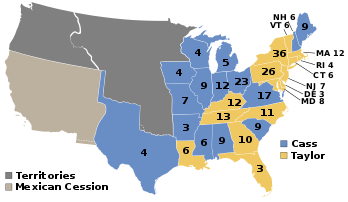 | |||||||||||||||||||||||||||||||||||||
| |||||||||||||||||||||||||||||||||||||
The 1848 United States presidential election was the 16th quadrennial presidential election, held on Tuesday, November 7, 1848. In the aftermath of the Mexican–American War, General Zachary Taylor of the Whig Party defeated Senator Lewis Cass of the Democratic Party.
Despite Taylor's unclear political affiliations and beliefs, and the Whig opposition to the Mexican–American War, the 1848 Whig National Convention nominated the popular general over party stalwarts such as Henry Clay and Daniel Webster. For vice president, the Whigs nominated Millard Fillmore, a New York Whig known for his moderate views on slavery. Incumbent President James K. Polk, a Democrat, honored his promise not to seek re-election, leaving his party's nomination open. The 1848 Democratic National Convention rejected former President Martin Van Buren's bid for a second term, instead nominating Senator Lewis Cass of Michigan. Van Buren broke from his party to lead the ticket of the Free Soil Party, which opposed the extension of slavery into the territories.
The Whig choice of Zachary Taylor was made almost out of desperation; he was not clearly committed to Whig principles, but he was popular for leading the war effort. The Democrats had a record of prosperity and had acquired the Mexican cession and parts of Oregon country. It appeared almost certain that they would win unless the Whigs picked Taylor. Taylor won a plurality of the popular vote and a majority of the electoral vote, while Van Buren won 10.1% of the popular vote, a strong showing for a third party candidate.
Taylor's victory made him the second of two Whigs to win a presidential election, following William Henry Harrison's victory in the 1840 presidential election. Like Harrison, Taylor died during his term, and he was succeeded by Fillmore. Discounting Republican Abraham Lincoln's 1864 re-election on the National Union ticket, Taylor is the most recent individual who was not a member of the Democratic or Republican parties to win a presidential election. The contest was the first presidential election that took place on the same day in every state, and it was the first time that Election Day was statutorily a Tuesday.
Nominations
Whig Party nomination
Main article: 1848 Whig National Convention| 1848 Whig Party ticket | |||||||||||||||||||||||||||||
| Zachary Taylor | Millard Fillmore | ||||||||||||||||||||||||||||
|---|---|---|---|---|---|---|---|---|---|---|---|---|---|---|---|---|---|---|---|---|---|---|---|---|---|---|---|---|---|
| for President | for Vice President | ||||||||||||||||||||||||||||
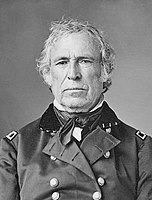 |
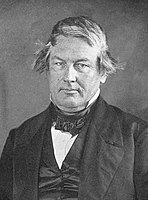 | ||||||||||||||||||||||||||||
| Major general of the U.S. Army (1846–1849) |
14th New York State Comptroller (1848–1849) | ||||||||||||||||||||||||||||
| Campaign | |||||||||||||||||||||||||||||

Mexican–American War General Zachary Taylor of Kentucky, an attractive candidate because of his successes on the battlefield, but who had never voted in an election himself, was openly courted by both the Democratic and Whig parties. Taylor ultimately declared himself a Whig, and easily took their nomination, receiving 171 delegate votes to defeat Henry Clay, Winfield Scott, Daniel Webster and others.
After Webster turned down the vice-presidential candidacy, Millard Fillmore received the party's nomination for vice-president, defeating—among others—Abbott Lawrence, a Massachusetts politician whose mild opposition to slavery led him to be dubbed a "Cotton Whig".
Democratic Party nomination
Main article: 1848 Democratic National Convention| Lewis Cass | William O. Butler | ||||||||||||||||||||||||||||
|---|---|---|---|---|---|---|---|---|---|---|---|---|---|---|---|---|---|---|---|---|---|---|---|---|---|---|---|---|---|
| for President | for Vice President | ||||||||||||||||||||||||||||
 |
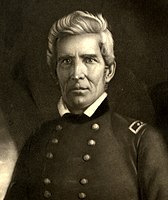 | ||||||||||||||||||||||||||||
| U.S. Senator from Michigan (1845–1848) |
Former U.S. Representative for Kentucky's 13th (1839–1843) | ||||||||||||||||||||||||||||
| Campaign | |||||||||||||||||||||||||||||

Former President Martin Van Buren once again sought the Democratic nomination, but withdrew before balloting began due to a dispute over the seating of the New York delegation, which culminated in the convention voting that half of the state's delegates be made up of the anti-slavery "Barnburner" faction lead by Van Buren, with the remaining half from the pro-slavery "Hunker" faction. Van Buren, knowing he had no feasible path to winning the nomination without the full support of the New York delegation, lead the Barnburners in withdrawing from the convention. The Hunkers, upset that they were not allowed to take the vacated seats of their Barnburner counterparts, likewise withdrew.
As a result of Van Buren's withdrawal, Senator Lewis Cass and incumbent Secretary of State James Buchanan were seen as the only serious contenders for the nomination, with a draft effort also focusing on Supreme Court associate justice Levi Woodbury. In stark contrast to the highly contested and protracted convention at the previous (and subsequent) election, Cass held a wide lead on all four ballots, only being denied victory on the third due to the convention rules stipulating that the votes of the absent New York delegates still counted towards the required two-thirds majority, before the Buchanan and Woodbury campaigns quietly released enough delegates to allow Cass victory on the fourth ballot. Cass had served as Governor and Senator for Michigan, as well as Secretary of War under Andrew Jackson, and from 1836 to 1842 as ambassador to France. General William O. Butler was nominated to join Cass on the ticket, garnering 169 delegate votes to defeat five other candidates, including future Vice-President William R. King and future Confederate President Jefferson Davis.
Though he had made few public statements on the matter, Cass had long been suspected of pro-slavery leanings (Butler was known to be a moderate abolitionist, albeit he still owned slaves himself), and the convention agreed on a platform that made no mention of the issue. This failed to mollify Van Buren's supporters, most of whom bolted to form the Free Soil Party, eventually followed by Van Buren himself.
Free Soil Party nomination
Main article: 1848 Free Soil & Liberty national conventions| Free Soil Party Ticket, 1848 | |||||||||||||||||||||||||||||
| Martin Van Buren | Charles Francis Adams | ||||||||||||||||||||||||||||
|---|---|---|---|---|---|---|---|---|---|---|---|---|---|---|---|---|---|---|---|---|---|---|---|---|---|---|---|---|---|
| for President | for Vice President | ||||||||||||||||||||||||||||
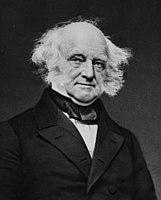 |
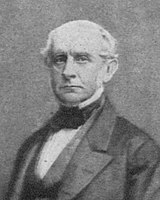 | ||||||||||||||||||||||||||||
| 8th President of the United States (1837–1841) |
Former Massachusetts State Senator (1844–1845) | ||||||||||||||||||||||||||||
| Campaign | |||||||||||||||||||||||||||||
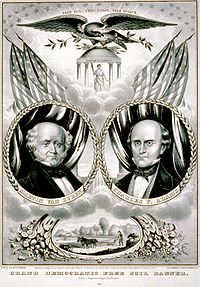
The Free Soil Party was organized for the 1848 election to oppose further expansion of slavery into the western territories. Much of its support came from disaffected anti-slavery Barnburner Democrats and Conscience Whigs, including former President Martin Van Buren. The party was led by Salmon P. Chase and John Parker Hale and held its 1848 convention in Utica and Buffalo, New York. On June 22, Van Buren defeated Hale by a 154-129 delegate count to capture the Free Soil nomination, while Charles Francis Adams, whose father (John Quincy Adams) and grandfather (John Adams) had both served as president, was chosen as the vice-presidential nominee.
Van Buren knew that the Free Soilers had not the slightest chance of winning, rather that his candidacy would split the Democratic vote and throw the election to the Whigs. Bitter and aging, Van Buren did not care despite the fact that his life had been built upon the rock of party solidarity and party regularity. He loathed Lewis Cass and the principle of popular sovereignty with equal intensity.
Liberty Party nomination
Main article: 1848 Free Soil & Liberty national conventionsDespite their significant showing in the prior presidential election, certain events would conspire to remove the Liberty Party from political significance.
Initially, the nomination was to be decided in the fall of 1847 at a Convention in Buffalo, New York. There, Senator John P. Hale was nominated over Gerrit Smith, brother-in-law to the party's previous nominee James G. Birney. Leicester King, a former judge and state senator in Ohio, was nominated to be Hale's running mate. Anti-slavery Democrats and Whigs, disappointed with their respective nominees, would form a new movement in conjunction with members of the Liberty Party such as John Hale and Salmon Chase to form the Free Soil Party that summer. At this point, both Hale and King withdrew in favor of a Free Soil ticket led by former President Martin Van Buren, and the great majority of members of the Liberty Party followed them into the new political party. A small faction refused to support Van Buren for the presidency, however. They held another convention in June 1848 as the "National Liberty Party." Gerrit Smith was nominated almost unanimously with Charles Foote, a religious minister from Michigan, as his running-mate.
Other nominations
The Native American Party, a precursor to the Know Nothings, which had split from the Whig Party in 1845, met in September 1847 in Philadelphia, where they nominated Zachary Taylor for president and Henry A. S. Dearborn of Massachusetts for vice-president. However, when the Whig Party nominated Taylor for the presidency with Millard Fillmore as his running mate the following year, this rendered his previous nomination moot and the Native American Party failed to make an alternate nomination.
General election
Campaign
The campaign was fought without much enthusiasm, and practically without an issue. Neither of the two great parties made an effort to rally the people to the defense of any important principle.
Whig campaigners, who included Abraham Lincoln and Rutherford B. Hayes, talked up Taylor's "antiparty" opposition to the Jacksonian commitment to the spoils system and yellow-dog partisanship. In the South, they stressed that he was a Louisiana slaveholder, while in the North they highlighted his Whiggish willingness to defer to Congress on major issues (which he subsequently did not do).
Democrats repeated, as they had for many years, their opposition to a national bank, high tariffs, and federal subsidies for local improvements. The Free Soilers branded both major parties lackeys of the Slave Arm, arguing that the rich planters controlled the agenda of both parties, leaving the ordinary white man out of the picture. They had to work around Van Buren's well-known reputation for compromising with slavery.
The Whigs had the advantage of highlighting Taylor's military glories. With Taylor remaining vague on the issues, the campaign was dominated by personalities and personal attacks, with the Democrats calling Taylor vulgar, uneducated, cruel and greedy, and the Whigs attacking Cass for graft and dishonesty. The division of the Democrats over slavery allowed Taylor to dominate the Northeast.
The Free Soilers were on the ballots in only 17 of the 29 states with the popular vote, making it mathematically possible for Van Buren to win the presidency, but he had no real chance. Still, the party campaigned vigorously, particularly in the traditional Democrat strongholds in the northeast.
While some Free Soilers were hopeful of taking enough states to throw the election into the House of Representatives, Van Buren himself knew this was a long shot and that the best that his party could do was lay the groundwork for a hopefully improved showing in 1852.
1848 campaign artwork
-
 Artwork for "Fort Harrison March," a campaign song for Zachary Taylor's presidential campaign which recalled his triumph at the Siege of Fort Harrison in 1812.
Artwork for "Fort Harrison March," a campaign song for Zachary Taylor's presidential campaign which recalled his triumph at the Siege of Fort Harrison in 1812.
-
 Political cartoon about the election campaign, titled "Shooting the Christmas Turkey"
Political cartoon about the election campaign, titled "Shooting the Christmas Turkey"
-
 "Grand Presidential sweep-stakes" - political cartoon of the three main candidates
"Grand Presidential sweep-stakes" - political cartoon of the three main candidates
Results


With Taylor as their candidate, the Whigs won their second and last victory in a Presidential election. Taylor won the electoral college by capturing 163 of the 290 electoral votes, while the popular vote was close: Taylor out-polled Cass in the popular vote by 138,000 votes, winning 47% of the popular vote, and was elected president.
A shift of less than 6000 votes to Cass in Georgia and Maryland would have left the electoral college in a 145–145 tie, while a shift of less than 27,000 votes to Van Buren in Connecticut, Maine and Massachusetts would have left both Taylor and Cass short of the 146 electoral votes required to win, forcing a contingent election in the House of Representatives.
A study of the county returns reveals that Free Soil strength drawn at the expense of the major parties differed by region. In the East North Central States, it appears at least the majority of the Free Soil strength was drawn from the Whig Party.
Conversely, in the Middle Atlantic region, Free Soil bases of strength lay in the areas which had hitherto been Democratic, particularly in New York and northern Pennsylvania. The Free Soil Democrats nomination of Van Buren made the victory of Taylor nearly certain in New York. On election day, enough Democratic votes were drawn away by Van Buren to give the Whig ticket all but two Democratic counties, thus enabling it to carry hitherto impregnable parts of upper New York state. The Democrats, confronted with an irreparable schism in New York, lost the election.
In New England, the Democratic vote declined by 33,000 from its 1844 level, while the Whig vote likewise declined by 15,000 votes. The third-party vote tripled, and the total vote remained nearly stationary: a partial indication, perhaps, of the derivation of the Free Soil strength in this section. For the first time since the existence of the Whig Party, the Whigs failed to gain an absolute majority of the vote in Massachusetts and Vermont. In addition, the Democrats failed to retain their usual majority in Maine; thus only New Hampshire (Democratic) and Rhode Island (Whig) of the states in this section gave their respective victorious parties clear-cut majorities.
Of the 1,464 counties/independent cities making returns, Cass placed first in 753 (51.43%), Taylor in 676 (46.17%), and Van Buren in 31 (2.12%). Four counties (0.27%) in the West split evenly between Taylor and Cass. This was the first time in the Second Party System in which the victorious party failed to gain at least a plurality of the counties as well as of the popular vote.
As one historian remarks, somewhat sarcastically, practically the only thing it decided was that a Whig general should be made President because he had done effective work in carrying on a Democratic war.
This was the last election in which Connecticut, Delaware, Florida, Georgia, Louisiana, Maryland, New Jersey, New York, North Carolina, Pennsylvania, and Rhode Island voted for the Whigs. It was also the last time that Georgia voted against the Democrats until 1964, the last time Delaware and Louisiana did so until 1872, the last time Florida and North Carolina did so until 1868, and the last time New Jersey and Pennsylvania did so until 1860.
| Presidential candidate | Party | Home state | Popular vote | Electoral vote |
Running mate | |||
|---|---|---|---|---|---|---|---|---|
| Count | Percentage | Vice-presidential candidate | Home state | Electoral vote | ||||
| Zachary Taylor | Whig | Louisiana | 1,361,393 | 47.28% | 163 | Millard Fillmore | New York | 163 |
| Lewis Cass | Democratic | Michigan | 1,223,460 | 42.49% | 127 | William Orlando Butler | Kentucky | 127 |
| Martin Van Buren | Free Soil | New York | 291,501 | 10.12% | 0 | Charles Francis Adams Sr. | Massachusetts | 0 |
| Gerrit Smith | Liberty | New York | 2,545 | 0.09% | 0 | Charles C. Foote | Michigan | 0 |
| Other | 285 | 0.01% | — | Other | — | |||
| Total | 2,879,184 | 100% | 290 | 290 | ||||
| Needed to win | 146 | 146 | ||||||
Source (Popular Vote): Leip, David. "1848 Presidential Election Results". Dave Leip's Atlas of U.S. Presidential Elections. Retrieved July 27, 2005. Source (Electoral Vote): "Electoral College Box Scores 1789–1996". National Archives and Records Administration. Retrieved July 31, 2005. The popular vote figures exclude South Carolina where the Electors were chosen by the state legislature rather than by popular vote.
| ||||||||||||||||||||||||||||||
| ||||||||||||||||||||
Geography of results
Cartographic gallery
-
 Map of presidential election results by county
Map of presidential election results by county
-
 Map of Whig presidential election results by county
Map of Whig presidential election results by county
-
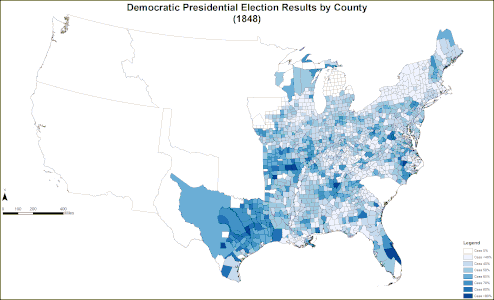 Map of Democratic presidential election results by county
Map of Democratic presidential election results by county
-
 Map of Free Soil presidential election results by county
Map of Free Soil presidential election results by county
-
 Map of Liberty presidential election results by county
Map of Liberty presidential election results by county
-
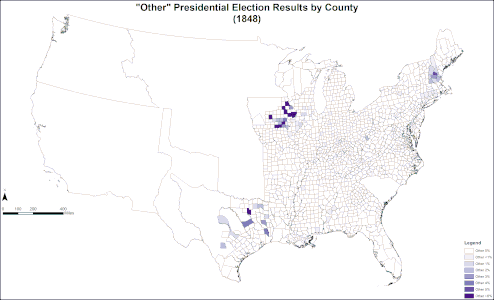 Map of "Other" presidential election results by county
Map of "Other" presidential election results by county
-
 Cartogram of presidential election results by county
Cartogram of presidential election results by county
-
 Cartogram of Whig presidential election results by county
Cartogram of Whig presidential election results by county
-
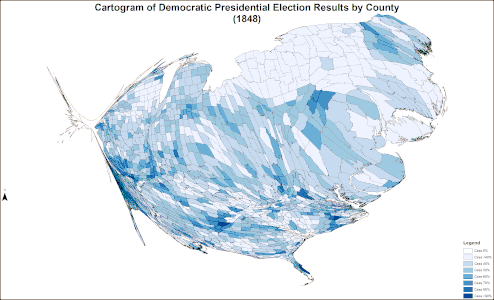 Cartogram of Democratic presidential election results by county
Cartogram of Democratic presidential election results by county
-
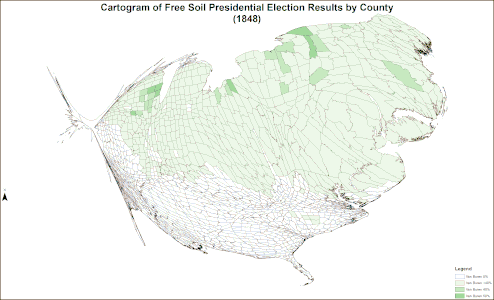 Cartogram of Free Soil presidential election results by county
Cartogram of Free Soil presidential election results by county
-
 Cartogram of Liberty presidential election results by county
Cartogram of Liberty presidential election results by county
-
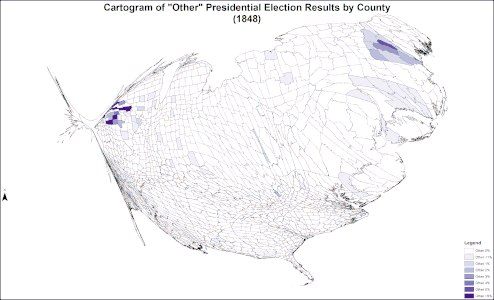 Cartogram of "Other" presidential election results by county
Cartogram of "Other" presidential election results by county
Results by state
This was the first election where the two leading candidates each carried half of the states. As of 2018, it has subsequently happened just once, in 1880. Source: Data from Walter Dean Burnham, Presidential ballots, 1836–1892 (Johns Hopkins University Press, 1955) pp 247–57.
| States/districts won by Cass/Butler |
| States/districts won by Taylor/Fillmore |
| Zachary Taylor Whig |
Lewis Cass Democratic |
Martin Van Buren Free Soil |
Margin | State Total | ||||||||||||||
|---|---|---|---|---|---|---|---|---|---|---|---|---|---|---|---|---|---|---|
| State | electoral votes |
# | % | electoral votes |
# | % | electoral votes |
# | % | electoral votes |
# | % | # | |||||
| Alabama | 9 | 0001361830,482 | 49.44 | - | 0004866931,173 | 50.56 | 9 | no ballots | -691 | -1.12 | 61,655 | AL | ||||||
| Arkansas | 3 | 7,587 | 44.93 | - | 9,301 | 55.07 | 3 | no ballots | -1,714 | -10.14 | 16,888 | AR | ||||||
| Connecticut | 6 | 30,318 | 48.59 | 6 | 27,051 | 43.35 | - | 5,005 | 8.02 | - | 3,267 | 5.24 | 62,398 | CT | ||||
| Delaware | 3 | 6,440 | 51.80 | 3 | 5,910 | 47.54 | - | 82 | 0.66 | - | 530 | 4.26 | 12,423 | DE | ||||
| Florida | 3 | 4,120 | 57.20 | 3 | 3,083 | 42.80 | - | no ballots | 1,037 | 14.40 | 7,203 | FL | ||||||
| Georgia | 10 | 47,532 | 51.49 | 10 | 44,785 | 48.51 | - | no ballots | 2,747 | 2.98 | 92,317 | GA | ||||||
| Illinois | 9 | 52,853 | 42.42 | - | 55,952 | 44.91 | 9 | 15,702 | 12.60 | - | -3,099 | -2.49 | 124,596 | IL | ||||
| Indiana | 12 | 69,907 | 45.77 | - | 74,745 | 48.93 | 12 | 8,100 | 5.30 | - | -4,838 | -3.16 | 152,752 | IN | ||||
| Iowa | 4 | 9,930 | 44.59 | - | 11,238 | 50.46 | 4 | 1,103 | 4.95 | - | -1,308 | -5.87 | 22,271 | IA | ||||
| Kentucky | 12 | 67,145 | 57.46 | 12 | 49,720 | 42.54 | - | no ballots | 17,425 | 14.92 | 116,865 | KY | ||||||
| Louisiana | 6 | 18,487 | 54.59 | 6 | 15,379 | 45.41 | - | no ballots | 3,108 | 9.18 | 33,866 | LA | ||||||
| Maine | 9 | 35,273 | 40.25 | - | 40,195 | 45.87 | 9 | 12,157 | 13.87 | - | -4,922 | -5.62 | 87,625 | ME | ||||
| Maryland | 8 | 37,702 | 52.10 | 8 | 34,528 | 47.72 | - | 129 | 0.18 | - | 3,174 | 4.38 | 72,359 | MD | ||||
| Massachusetts | 12 | 61,072 | 45.32 | 12 | 35,281 | 26.18 | - | 38,333 | 28.45 | - | 22,739 | 16.87 | 134,748 | MA | ||||
| Michigan | 5 | 23,947 | 36.80 | - | 30,742 | 47.24 | 5 | 10,393 | 15.97 | - | -6,795 | -10.44 | 65,082 | MI | ||||
| Mississippi | 6 | 25,911 | 49.40 | - | 26,545 | 50.60 | 6 | no ballots | -634 | -1.20 | 52,456 | MS | ||||||
| Missouri | 7 | 32,671 | 44.91 | - | 40,077 | 55.09 | 7 | no ballots | -7,406 | -10.18 | 72,748 | MO | ||||||
| New Hampshire | 6 | 14,781 | 29.50 | - | 27,763 | 55.41 | 6 | 7,560 | 15.09 | - | -12,982 | -25.91 | 50,104 | NH | ||||
| New Jersey | 7 | 40,015 | 51.48 | 7 | 36,901 | 47.47 | - | 819 | 1.05 | - | 3,114 | 4.01 | 77,735 | NJ | ||||
| New York | 36 | 218,583 | 47.94 | 36 | 114,319 | 25.07 | - | 120,497 | 26.43 | - | 98,086 | 21.51 | 455,944 | NY | ||||
| North Carolina | 11 | 44,054 | 55.17 | 11 | 35,772 | 44.80 | - | no ballots | 8,282 | 10.37 | 79,826 | NC | ||||||
| Ohio | 23 | 138,359 | 42.12 | - | 154,773 | 47.12 | 23 | 35,347 | 10.76 | - | -16,414 | -5.00 | 328,479 | OH | ||||
| Pennsylvania | 26 | 185,313 | 50.28 | 26 | 171,976 | 46.66 | - | 11,263 | 3.06 | - | 13,337 | 3.62 | 368,552 | PA | ||||
| Rhode Island | 4 | 6,779 | 60.77 | 4 | 3,646 | 32.68 | - | 730 | 6.54 | - | 3,133 | 28.09 | 11,155 | RI | ||||
| South Carolina | 9 | no popular vote | no popular vote | 9 | no popular vote | - | - | - | SC | |||||||||
| Tennessee | 13 | 64,321 | 52.52 | 13 | 58,142 | 47.48 | - | no ballots | 6,179 | 5.04 | 122,463 | TN | ||||||
| Texas | 4 | 4,509 | 29.71 | - | 10,668 | 70.29 | 4 | no ballots | -6,159 | -40.58 | 15,177 | TX | ||||||
| Vermont | 6 | 23,132 | 48.27 | 6 | 10,948 | 22.85 | - | 13,837 | 28.87 | - | 9,295 | 19.40 | 47,922 | VT | ||||
| Virginia | 17 | 45,265 | 49.20 | - | 46,739 | 50.80 | 17 | no ballots | -1,474 | -1.60 | 92,004 | VA | ||||||
| Wisconsin | 4 | 13,747 | 35.10 | - | 15,001 | 38.30 | 4 | 10,418 | 26.60 | - | -1,254 | -3.20 | 39,166 | WI | ||||
| TOTALS: | 290 | 1,360,235 | 47.28 | 163 | 1,222,353 | 42.49 | 127 | 291,475 | 10.13 | - | 2,876,818 | US | ||||||
| TO WIN: | 146 | |||||||||||||||||
Close states
States where the margin of victory was under 5%:
- Alabama 1.12%
- Misisssippi 1.2%
- Virginia 1.6%
- Illinois 2.49%
- Georgia 2.98%
- Indiana 3.16%
- Wisconsin 3.2%
- Pennsylvania 3.62% (tipping point state)
- New Jersey 4.01%
- Delaware 4.26%
- Maryland 4.38%
Electoral college selection
| Method of choosing electors | State(s) |
|---|---|
| Each Elector appointed by state legislature | South Carolina |
| Each Elector chosen by voters statewide | (all other States) * |
* Massachusetts law provided that the state legislature would choose the Electors if no slate of Electors could command a majority of voters statewide. In 1848, this provision was triggered.
See also
- 1848 and 1849 United States House of Representatives elections
- 1848 and 1849 United States Senate elections
- American election campaigns in the 19th century
- History of the United States (1789–1849)
- Inauguration of Zachary Taylor
References
- "Voter Turnout in Presidential Elections". The American Presidency Project. UC Santa Barbara.
- Allan Nevins, Ordeal of the Union: Volume I. Fruits of Manifest Destiny, 1847–1852 (1947).
- President Elect – Previous Trivia Of The Week, archived from the original on August 11, 2017, retrieved September 17, 2017
- Luthin, Richard H. (December 1941). "Abraham Lincoln and the Massachusetts Whigs in 1848". The New England Quarterly. 14 (4): 621–622. doi:10.2307/360598. JSTOR 360598.
- Stone, Irving (1966). They Also Ran: The Story of the Men who were Defeated for the Presidency. Garden City, NY: Doubleday. p. 262.
- They Also Ran, Irving Stone, pg. 263
- Silbey (2009)
- weber, balmer and; h., weber, c. "Image 1 of Fort Harrison march". Archived from the original on July 10, 2012.
{{cite web}}: CS1 maint: multiple names: authors list (link)
Bibliography
- Blue, Frederick J. The Free Soilers: Third Party Politics, 1848–54 (1973).
- Boritt, G. S. "Lincoln's Opposition to the Mexican War," Journal of the Illinois State Historical Society Vol. 67, No. 1, Abraham Lincoln Issue (Feb. 1974), pp. 79–100 in JSTOR
- Earle, Jonathan H. Jacksonian Antislavery and the Politics of Free Soil, 1828–1854 (2004).
- Eyal, Yonatan. "The 'Party Period' Framework and the Election of 1848", Reviews in American History Volume 38, Number 1, March 2010, in Project Muse
- Graebner, Norman A. "Thomas Corwin and the Election of 1848: A Study in Conservative Politics." Journal of Southern History, 17 (1951), 162–79. in JSTOR
- Hamilton, Holman. Zachary Taylor: Soldier in the White House (1951)
- Hamilton, Holman.
- Holt; Michael F. The Rise and Fall of the American Whig Party: Jacksonian Politics and the Onset of the Civil War. (1999). online edition
- Morrison, Michael A. "New Territory versus No Territory": The Whig Party and the Politics of Western Expansion, 1846–1848," Western Historical Quarterly, Vol. 23, No. 1 (Feb. 1992), pp. 25–51 in JSTOR
- Nevins, Allan. Ordeal of the Union: Volume I. Fruits of Manifest Destiny, 1847–1852 (1947).
- Quist, John W. "The Election of 1848." in American Presidential Campaigns and Elections (Routledge, 2020) pp. 328-348.
- Rayback, Joseph G. Free Soil: The Election of 1848. (1970).
- Silbey, Joel H. Party Over Section: The Rough and Ready Presidential Election of 1848 (2009). 205 pp.
Primary sources
- Chester, Edward W A guide to political platforms (1977) online
- Porter, Kirk H. and Donald Bruce Johnson, eds. National party platforms, 1840-1964 (1965) online 1840-1956
External links
- United States presidential election of 1848 at the Encyclopædia Britannica
- Presidential Election of 1848: A Resource Guide from the Library of Congress
- 1848 popular vote by counties
- 1848 Election State-by-State popular results
- The Election of 1848
- How close was the 1848 election? — Michael Sheppard, Massachusetts Institute of Technology
- Election of 1848 in Counting the Votes
| (← 1844) 1848 United States presidential election (1852 →) | |||||
|---|---|---|---|---|---|
| Whig Party (Convention) |
| ||||
| Democratic Party (Convention) |
| ||||
| Free Soil Party (Convention) |
| ||||
| State and district results of the 1848 United States presidential election | ||
|---|---|---|
 | ||


